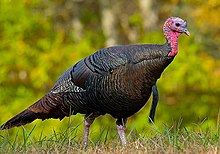Turkey (bird)
genus of large ground-feeding birds native to the Americas
Turkeys are birds in the genus Meleagris. They are like a chicken but much bigger. Wild turkeys live in forests in North America and Central America. In the United States, people traditionally eat turkey on the holiday of Thanksgiving.
| Turkey Temporal range: Early Miocene – Recent
| |
|---|---|

| |
| Wild turkey | |
| Scientific classification | |
| Domain: | Eukaryota |
| Kingdom: | Animalia |
| Phylum: | Chordata |
| Class: | Aves |
| Order: | Galliformes |
| Family: | Phasianidae |
| Subfamily: | Meleagridinae |
| Genus: | Meleagris Linnaeus, 1758 |
| Species | |

This genus has two species:
- Wild turkey (Meleagris gallopavo)
- Ocellated turkey (Meleagris ocellata)
Naming
changeWhen people from Europe first saw turkeys in the Americas they thought the birds were a type of guinea fowl (Numida meleagris). This bird had been brought to central Europe from the country of Turkey. The name of that country stuck as the name of the bird.[1]
The confusion with the name is also seen in the scientific name: meleagris is Greek for guinea-fowl.
References
change- ↑ Messenger, Stephen (23 November 2010). "Naming of the Turkey". How an American Bird Got the Name 'Turkey'. The Guardian. Retrieved 23 September 2016.
Other websites
changeMedia related to Meleagris at Wikimedia Commons